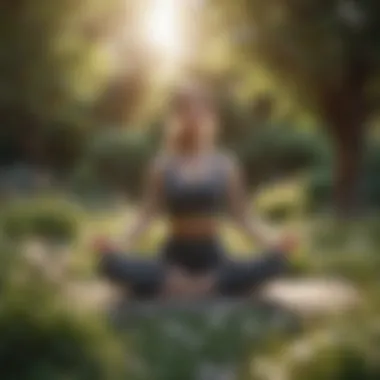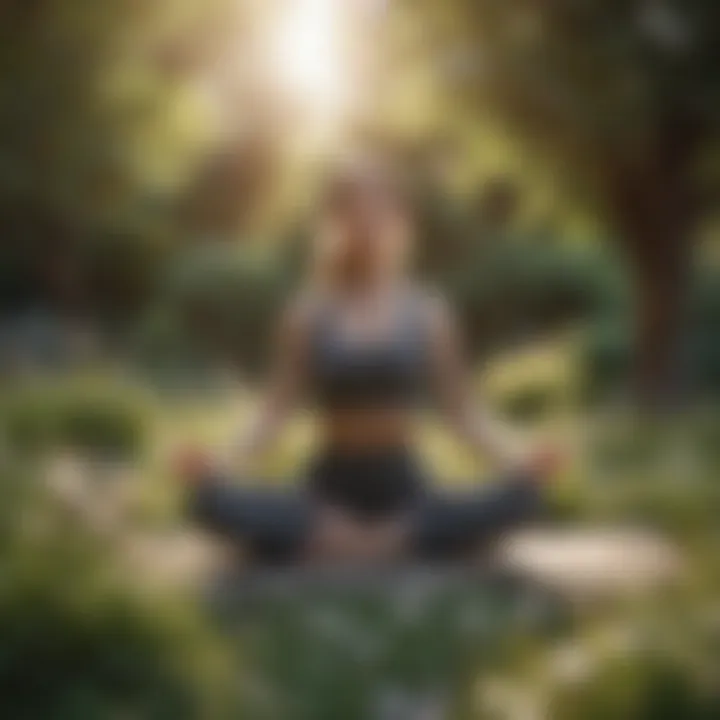Mindful Pursuits: Activities for Mental Clarity


Intro
In today’s whirlwind of responsibilities and distractions, finding a moment of peace often resembles looking for a needle in a haystack. Amidst the hustle and bustle, many are turning towards activities that nurture mindfulness and foster a sense of serenity. This article dives into various calming pursuits, aimed specifically at cultivating mental clarity.
Understanding how to be present in the moment can be transformative. By prioritizing personal well-being, individuals can navigate their day-to-day struggles more effortlessly. Instead of letting stress snowball, incorporating simple yet effective practices can lead to a more tranquil mind and improved mental health.
As we explore different guided meditation styles, engage with nature, and use various practical techniques, readers will unearth effective ways to integrate these calming practices into their busy lives. Whether you’re just dipping your toes into mindfulness or you are a seasoned practitioner, this guide offers insights and information tailored for everyone.
Types of Guided Meditation
Mindfulness Meditation
Mindfulness meditation is about becoming more aware of your thoughts and feelings without judgment. It's the practice of paying attention to the present moment. During these sessions, a guide often leads participants through various techniques that help ground them and alleviate racing thoughts. Tasks like focusing on the breath or observing the sensory experiences around can lead to a deeper understanding of one’s mind.
Sleep Meditation
Sleep meditation is tailored for individuals who have trouble falling asleep or staying asleep. This practice usually involves a soothing voice guiding participants to relax their bodies and clear their minds. By weaving in gentle visualization, deep breathing techniques, and soft sounds, sleep meditation can assist in ushering in a state of calm conducive for a good night’s rest.
"Meditation is the soul's perspective glass." — Ephraim Kehdoura
Benefits of Guided Meditation
Both mindfulness and sleep meditation, along with other forms of guided meditation, afford numerous benefits that can significantly improve mental well-being:
- Mental Clarity and Focus
Engaging in guided meditation promotes sharper focus and helps clear away the fog of stress and distractions. Studies suggest that regular practice can even help enhance cognitive abilities and decision-making skills. - Improved Sleep Quality
Practicing sleep meditation reps can lead to noticeably better sleep. It has been shown to increase the production of melatonin, a hormone that helps regulate sleep cycles, allowing the body to enjoy restorative sleep.
Incorporating these mindful activities could bring about profound changes to your mental wellbeing. Taking a step towards calming activities can open doors to tranquility and clarity that is often missed by our fast-paced lives.
Understanding Calmness
Calmness is often seen as a sanctuary from chaos, providing a necessary respite in a world that rarely slows down. Achieving a state of calmness is not merely a luxury; it’s fundamental to mental health and emotional stability. It acts as the bedrock upon which other mindful practices can be built. When individuals embrace calmness, they unlock the door to greater clarity of thought and improved overall well-being.
The Importance of Tranquility
Tranquility holds a unique place in our lives, like a smooth surface of water reflecting the sky. It allows us to step back from the daily grind and re-engage with our own thoughts, free from noise and distraction. The benefits of cultivating tranquility are manifold:
- Enhanced Focus: When our minds are calm, we can concentrate better on tasks, leading to increased productivity.
- Stress Reduction: A tranquil mind naturally mitigates stress levels, helping to stave off anxiety that often accompanies a busy lifestyle.
- Improved Relationships: Approaching interactions from a place of calm fosters better communication and understanding with others.
Furthermore, tranquility invites pauses into the chaos. It encourages us to deliberately slow down and savor moments, allowing us to reflect on our experiences without being swept away by them.
Mindfulness Defined
Mindfulness, in its essence, refers to the practice of being fully present in the moment. It requires deliberate attention to thoughts, feelings, and sensations rather than being caught in the current of daily distractions. It can be a game-changer in tackling stress and anxiety.
When one engages in mindfulness, they are essentially stepping into a state of heightened awareness. This may seem trivial, yet this practice enables deeper connections with both oneself and the surrounding world.
In this context, mindfulness can manifest in various ways:
- Mindful Eating: Paying attention to the flavors and textures of food can transform mealtimes into rich, sensory experiences.
- Mindful Listening: Really tuning in during conversations can strengthen relationships and foster empathy.
- Breathing Practices: Techniques that focus on breath can ground thoughts and create a sense of calm.
Being mindful encourages a holistic awareness, connecting the individual with their environment while promoting an understanding of their internal state. As this awareness grows, so does the ability to act with clarity rather than impulse.
"Mindfulness is a way of befriending ourselves and our experience." – Jon Kabat-Zinn
Engaging with these concepts not only strengthens the foundation for calming activities but also equips one for the challenges of modern life. Understanding calmness leads to more informed choices and a clearer path toward a tranquil existence.
Connection with Nature
Connecting with nature plays a pivotal role in achieving mindfulness and mental clarity. The hustle and bustle of modern life often pulls individuals away from the soothing embrace of the natural world. By taking time to immerse oneself in nature, people can effectively alleviate stress, find respite from life’s demands, and foster a deeper sense of well-being. The restorative qualities of nature influence both mental and physical health. In this section, we will explore the numerous benefits of outdoor activities and the practice of mindful walks, reinforcing how these pursuits can significantly enhance clarity and tranquility.
Benefits of Outdoor Activities
Spending time outdoors significantly boosts mental health through various mechanisms. Activities like hiking, gardening, or even simply sitting in a park can reduce symptoms of anxiety and depression. One key benefit is the reduction of cortisol, the stress hormone, which plummets when surrounded by greenery. Research indicates that even brief exposure to natural settings can lead to improved mood and reduced fatigue.
Additionally, outdoor pursuits often encourage physical activity, which in turn releases endorphins — natural mood lifters. Engaging in outdoor activities can also lead to enhanced creativity as the mind works more freely when disconnected from screens or hurried environments. The fresh air and sounds of nature stimulate the senses, redirecting focus and opening avenues for inspiration.
Taking Mindful Walks
Taking a mindful walk is a transformative practice that encourages individuals to slow down, be present, and engage with their surroundings. This simple act, performed with intention, can pave the way for greater awareness and clarity. During a mindful walk, one focuses on the rhythm of their breath and the sensations of each step, leading to a calmer state of mind.
Practicing Gratitude During Walks
Practicing gratitude during mindful walks is a profound way to enhance the overall experience. As one strolls, intentionally acknowledging aspects to be grateful for can shift the focus away from worries or stressors. This practice invites appreciation for the little things, like the sound of birds chirping or the beauty of blooming flowers. This process not only fosters a positive mindset but also strengthens the connection to the surrounding environment.
The hallmark of this practice lies in its simplicity. It can be easily incorporated into walking routines, making it a popular choice for those seeking mindfulness. Through this acknowledgment, individuals may notice an increase in their overall feelings of happiness and well-being.
"In the rush of daily life, we often forget to pause and appreciate the richness around us. Gratitude during walks becomes a gentle reminder to embrace the present."
Observing Surroundings
Observation during walks is another vital component of fostering mindfulness. This practice involves genuinely engaging with the sights, sounds, and smells around oneself. Instead of letting the mind wander or dwell on stressors, focusing fully on the environment enhances the sensory experience and grounds individuals in the moment.
This key characteristic promotes a greater understanding of one's surroundings; a person may notice small details that often go unseen in busy life. For instance, observing the shape of leaves or the different shades of the sky can foster a deeper connection to nature and oneself, contributing to overall personal growth.
Summary
In summary, the connection with nature presents a myriad of benefits that help in the pursuit of mental clarity and tranquility. Outdoor activities and mindful walks, complemented by practices like gratitude and observation, can significantly enhance one’s ability to remain present. These are essential pillars to nurturing a more peaceful and balanced mindset.
Creative Expression
Creative expression stands as a vital nexus within the realm of calming activities that foster mental clarity. It encompasses a wide range of artistic endeavors, inviting individuals to tap into their creativity to experience relaxation and self-discovery. Engaging in creative pursuits does more than just allow for self-expression; it encourages a dialogue with one’s inner self. This form of expression can serve as a potent outlet for emotions, easing stress and promoting mental well-being.


By embracing creativity, individuals discover the transformational effects it has on their psyche, leading to clearer thoughts and a more serene mind. Moreover, the act of creating often induces a state of flow, a concept recognized by psychologists, which not only distracts from daily worries but nurtures a profound connection between the mind and body.
Art as a Calming Tool
Painting and Drawing
Painting and drawing emerge as timeless mediums of creative expression that significantly contribute to calmness and mindfulness. The process of putting brush to canvas or pencil to paper engages the mind in a way that is both therapeutic and liberating. One of the most appealing characteristics of painting and drawing is their accessibility; anyone can pick up a tool and begin their journey into the world of art.
What distinguishes painting and drawing from other forms of expression is their ability to allow for immediate emotional release. The unique feature here is the tangible connection you form with colors and shapes, offering a visually stimulating experience that can transform your state of mind. Research has shown that engaging in these activities can lower anxiety levels and enhance emotional stability.
However, it’s essential to approach painting and drawing without the pressure of skill. It’s not about creating a masterpiece, but rather immersing oneself in the act itself. This freedom promotes a sense of playfulness, encouraging experimentation that can be incredibly beneficial.
Craft Projects
Craft projects introduce an additional layer of creativity that couples mind with task. Whether it’s knitting, scrapbooking, or building model airplanes, these projects require focus and patience, making them a great means to unwind. The key characteristic of craft projects lies in their tactile nature; working with various materials can feel grounding.
Crafting is particularly beneficial for those seeking structure in their calming practices. Unlike abstract art forms, craft projects often have guidelines and intended outcomes, which can be fulfilling especially for individuals who find comfort in predictability. They offer a sense of accomplishment once completed, further boosting mental clarity and satisfaction.
However, one of the potential drawbacks is the time investment and sometimes, the learning curve that can come with certain crafts. Some may find that the complexity of a project can lead to frustration rather than relaxation. Choosing crafts that align with personal interests and skill levels can mitigate this.
Journaling for Reflection
Journaling stands as a profoundly introspective practice that encourages reflection and clarity of thought. Its significance lies in its capacity to provide a safe space for self-exploration, enabling individuals to articulate feelings and thoughts that may otherwise remain unvoiced. The act of writing, whether guided by specific prompts or free-form journaling, fosters a deeper understanding of oneself, a core element of mindfulness.
Prompts for Mindfulness
Prompts for mindfulness serve as a springboard into deeper contemplation. They guide writers to focus on specific themes or emotions, allowing them to explore their inner worlds with intention. One of the distinguishing characteristics of these prompts is their ability to encourage individuals to engage with thoughts that might have gone unnoticed.
The unique feature of these prompts is their versatility; they can be tailored to meet the needs of the writer. Whether reflecting on gratitude, fear, or joy, these prompts invite a thorough examination of one’s mind. They help to unveil patterns in thinking, ultimately leading to greater mental clarity.
While they are widely regarded as beneficial, some might find it challenging to delve into certain emotions, which can be uncomfortable but ultimately rewarding. Creating a habit around journaling can help ease one into this practice.
Recording Thoughts and Emotions
Recording thoughts and emotions offers a more open-ended approach to journaling, providing the freedom to capture experiences in real-time. This practice forms a record that individuals can refer back to, helping them recognize how personal experiences shape their mental state over time. One key characteristic is the immediacy with which emotions can be documented, allowing for a direct outlet for feelings.
What makes this practice stand out is its reflective nature. Being able to look back on one’s thoughts not only fosters understanding but facilitates personal growth. Capturing the highs and lows provides a map of one’s emotional evolution.
Yet, one must consider potential drawbacks; frequent self-examination can lead to ruminating on negative thoughts. It’s essential to approach this practice with a balanced mindset, recognizing its value while remaining aware of the emotional implications it may carry.
Mindful Breathing Techniques
Breathing, while often overlooked, is a fundamental element in achieving mental clarity. Mindful breathing techniques help anchor individuals in the present moment, encouraging a deeper awareness of one’s body and thoughts. This process cultivates tranquility and assists in reducing stress levels, making it an essential practice in one’s journey toward mindfulness. When we consciously focus on our breath, we create space to revisit our thoughts without judgment and enhance our emotional regulation.
Understanding Breath Awareness
Breath awareness is the act of paying attention to one’s breathing patterns, noticing the rhythm and depth of each inhale and exhale. This practice lays the framework for mindfulness by promoting an understanding of how our emotional state can affect our breath. For instance, when anxiety strikes, we might notice short, quick breaths. Recognizing this can be the first step to regaining composure.
By fostering an awareness of breath, we empower ourselves to transition from a stressed state to one of calm. Additionally, focused breathing can sharpen concentration, enabling us to tackle challenges with renewed clarity.
Implementing Breathing Exercises
Diaphragmatic Breathing
Diaphragmatic breathing, also known as abdominal or deep breathing, involves fully engaging the diaphragm to inhale deeply. Instead of the chest rising, the belly expands, allowing for increased oxygen flow. This technique is popular in calming practices due to its ability to elicit a relaxation response throughout the body.
Key characteristic: The primary aspect of diaphragmatic breathing is its ability to slow the heart rate and lower blood pressure—creating a sense of calm.
Unique feature: One unique feature is how it can be performed anywhere—be it at home, in the office, or even during a commute. Over time, regular practice can lead to sustained levels of calmness and improved emotional health.
Box Breathing Technique
Box breathing, or four-square breathing, consists of four steps: inhaling, holding, exhaling, and holding again, each for the same duration—often four counts. This structured format makes it easy to remember and practice, particularly useful in high-stress situations.
Key characteristic: The simplicity of the Box Breathing Technique is its draw, as it gives practitioners a clear structure to regulate their breath.
Unique feature: Its systematic approach aids in fostering a peaceful mental space, enhancing focus, which is especially beneficial for those who find traditional meditation challenging.
The practice of breathing, although often disregarded, holds transformative powers in guiding us toward a more tranquil state of mind.
By incorporating these mindful breathing techniques into daily life, individuals can bolster their overall mental health, finding moments of peace even in the bustle of everyday activities. As they become more attuned to their breath, they inevitably weave greater mindfulness into their day, nurturing a serene inner world.
Meditation Practices
Meditation practices serve as a cornerstone for fostering mental clarity and promoting wellness. In a world that often feels like a whirlwind, dedicating time to meditate can be a guiding light of calm. These practices go beyond simple relaxation; they invite an exploration into the depths of the self, helping individuals find balance amid chaotic routines. When pursued regularly, meditation enhances focus, alleviates stress, and nurtures emotional resilience.
Guided Meditation Methods
Guided meditation methods act as helpful navigators in the often-uncharted territory of mindfulness.
Visualization Techniques
Visualization techniques focus on creating vivid mental images to foster relaxation and reduce anxiety. This method encourages individuals to picture serene landscapes or peaceful scenarios, guiding their minds towards a calm state. Such imagery is not just for aesthetic appreciation; it's an effective way of evoking emotional responses that promote tranquility. The key characteristic of visualization is its ability to transport practitioners away from their immediate concerns and into a realm of peaceful imagination.
- Unique feature: With visualization, practitioners often report heightened feelings of joy and comfort, as they mentally place themselves in ideal environments.
- Advantages: This approach can be particularly beneficial for those who struggle with traditional meditation methods, as it provides a tangible focus point.
- Disadvantages: However, if a practitioner finds it difficult to create mental images, they might feel frustration, which can detract from the overall experience.
Body Scan Meditations
Body scan meditations invite individuals to connect deeply with their physical sensations, drawing attention to different body parts in a sequential manner. This method offers a grounding experience and helps cultivate awareness of any areas of tension. Practitioners are encouraged to observe without judgment, allowing the body to release stress naturally.


- Key characteristic: The body scan technique emphasizes awareness and acceptance of physical states, which enhances the overall goal of self-connection.
- Unique feature: This practice can serve as a bridge for individuals who may be more attuned to physicality than abstract concepts.
- Advantages and disadvantages: While body scans can aid relaxation and foster deep introspection, they might also reveal feelings that some individuals may prefer to avoid. Thus, it requires an open-minded approach.
Cultivating a Daily Practice
Establishing a daily meditation routine is one of the most significant determinants of its effectiveness in cultivating mental clarity. Regular practice can lead to profound changes over time.
Setting Intentions
Setting intentions prior to meditation serves as a clarifying moment. This practice involves identifying specific goals or feelings one wishes to cultivate during the session. It’s a method of focusing the mind, anchoring thoughts, and fostering mindfulness. The key component of setting intentions is the mindful consideration of desires and aspirations that guide the meditation process.
- Unique feature: This preparatory step can enhance the overall meditation experience, as it gives a clear purpose.
- Advantages: Establishing intentions also fosters accountability, motivating practitioners to remain loyal to their practice.
- Disadvantages: However, practitioners may sometimes set overly ambitious intentions, leading to disappointment if those goals are not realized.
Creating a Meditation Space
Creating a meditation space is as much about environment as it is about mindset. This practice emphasizes altering a specific area within one’s home to cultivate focus and tranquility. Key elements often include soft lighting, comfortable seating, and perhaps some calming elements like candles or essential oils.
- Key characteristic: This personalized space encourages dedicated time for reflection, free from distractions.
- Unique feature: A meditative environment can often evoke feelings of safety and peace, making it easier for individuals to relax.
- Advantages and disadvantages: While establishing such a space can greatly enhance one's experience, it might also lead to psychological dependency on the environment, causing frustration when it's unavailable.
"Meditative practices derive their power not just from the act itself, but from the consistency and environment in which they are performed."
As individuals explore these varied forms of meditation, they pave pathways toward better mental health, demonstrating that even small commitments can yield significant benefits.
Mindful Movement
Mindful movement is a powerful tool that offers a path toward achieving mental clarity and emotional stability. It encompasses a variety of techniques that not only promote physical health but also nurture a deeper connection with oneself. Engaging in mindful movement activities fosters mindfulness, enhances body awareness, and creates a sense of inner peace. Whether through yoga, tai chi, or any form of gentle exercise, these practices encourage a heightened focus on breath, posture, and movement, allowing individuals to cultivate a calm and serene state of mind.
Exploring Yoga
Yoga is often seen as a cornerstone of mindful movement, blending physical activity with meditative practices. The beauty of yoga lies in its versatility, tailoring itself to meet diverse needs and preferences.
Types of Yoga for Calmness
When focusing on types of yoga that promote calmness, styles such as Hatha and Yin come to the forefront. Hatha yoga is characterized by its slow pace and gentle postures, making it accessible to practitioners of all levels. This style emphasizes breath control and encourages a relaxed mind. Yin yoga, on the other hand, involves holding poses for extended periods. This deep stretching not only unlocks tension in the body but also provides an opportunity for introspective reflection.
The key characteristic of these calming types of yoga is their slow, deliberate approach, which can help soothe the nervous system.
- Hatha Yoga Advantages:
- Yin Yoga Advantages:
- Accessible for beginners.
- Encourages relaxation through breathing.
- Deeply releases tension.
- Fosters mental clarity through stillness.
However, the slower pace of these styles may not suit everyone, especially those looking for higher energy workouts. It's essential to find the style that resonates with your body and mind.
Breath-Synchronized Movement
Breath-synchronized movement refers to the practice of aligning physical movements with breath, which is quintessential to yoga. This connection between breath and movement allows practitioners to enter a meditative state. As one flows in and out of poses, the breath acts as a guiding force, grounding the individual in the present moment.
The key feature of breath-synchronized movement is its ability to enhance focus and relaxation. As you learn to coordinate breath with movement, it becomes easier to silence the surrounding mental chatter. This practice can lead to:
- A more profound sense of mindfulness.
- Enhanced body awareness.
While this method is celebrated for its calming benefits, individuals may find it challenging at first. Developing a smooth breath pattern takes practice, and it’s perfectly normal to struggle initially.
Incorporating Tai Chi
Tai Chi is another mindful movement practice rooted in ancient Chinese traditions, often described as "meditation in motion." It is characterized by slow, flowing movements that promote balance and harmony within the body.
Flowing Movements
The essence of flowing movements in Tai Chi lies in their seamless transitions. Practitioners perform a series of postures connected together, which cultivates fluidity in the body. This gentle way of moving helps improve coordination and promote relaxation.
- Key Characteristic:
- Advantages:
- Emphasis on slow, deliberate movements.
- Aids in reducing stress.
- Improves flexibility and balance.
However, the tranquility of Tai Chi may sometimes be mistaken for simplicity, which can dissuade more vigorous exercise enthusiasts. Yet, the deep relaxation fostered by Tai Chi can be transformative.
Mind-Body Harmony
Mind-body harmony is the core philosophy of Tai Chi, focusing on the balance between physical, emotional, and spiritual aspects. The practice encourages awareness of the body’s sensations and emotions while cultivating a deeper appreciation for each movement.
This harmony is cultivated by:
- Practicing mindfulness during each movement.
- Connecting with one’s breath throughout the session.
While the richness of Tai Chi can engage the mind and body on multiple levels, some may find it hard to grasp initially. As with any practice, patience is key to uncovering the deeper benefits that these mindful movements can bring.
Embracing mindful movement—whether through yoga or tai chi—offers a myriad of benefits for mental tranquility. The journey toward calmness doesn't require perfection but rather a commitment to being present in each moment.
Embracing Stillness
In a world that often feels like it's running on fast-forward, embracing stillness can serve as a vital counterbalance to our hectic lives. This connection to calmness not only fosters mental clarity but also enhances our emotional well-being. Stillness helps us dig deeper into our thoughts, allowing for a clearer understanding of ourselves and our surroundings. It's a beacon guiding us back to our center when stress waves crash upon us.
Practicing Silence


Scheduled Quiet Time
One of the key aspects of scheduled quiet time is its simplicity. Dedicating a specific period in the day for silence can be a game-changer in reducing anxiety and enhancing focus. It can be as short as five minutes or long as an hour—whatever fits your lifestyle best. The beauty of this practice lies in its adaptability; anyone can fit this into their routine.
The primary characteristic of scheduled quiet time is its structured nature. By setting aside these moments, you designate a space for reflection, relaxation, and personal recharge. This makes it a beneficial choice, especially for those juggling multiple responsibilities. Moreover, the unique feature of this practice lies in its accessibility—no special equipment or training is necessary; you only need a calm room and your willingness to pause.
However, there are some disadvantages. For those who are not used to silence, the initial moments can feel uncomfortable or even overwhelming. The mind can often race, filled with thoughts that normally go unchecked. Yet, it’s within this discomfort that growth occurs, as the mind learns to settle and find peace amidst the chaos.
Silent Retreats
Silent retreats are another powerful avenue for embracing stillness. These immersive experiences allow individuals to step away from the noise of daily life, offering a unique opportunity to reconnect with oneself. Usually lasting from a few hours to several days, silent retreats provide a structured environment where verbal communication is limited.
The key characteristic of these retreats is the deep immersion in silence, which accelerates self-discovery and introspection. It's a strong choice for anyone who feels overwhelmed and seeks to distance themselves from everyday stressors. The unique feature of silent retreats often lies in the presence of a supportive community; although the focus is on silence, sharing this experience with others can foster a sense of belonging and connection.
However, they aren’t without drawbacks. Some individuals may find the silence challenging, especially if they are accustomed to a buzz of activity and conversation. The sudden shift can be jarring at first, and some might struggle with their thoughts during these periods. Yet, for many, overcoming this initial discomfort can lead to profound insights and a sense of peace that echoes long after the retreat ends.
Observing Thoughts
Mindful Observation Techniques
Mindful observation techniques center around the practice of watching one’s thoughts without judgment. This method encourages individuals to step back and acknowledge their thoughts as they occur, creating space between themselves and their mental processes. It contributes significantly to mental clarity, as it allows a clearer perspective on what occupies our minds.
The key characteristic of these techniques is their non-intrusive nature. They invite a gentle engagement with one’s thoughts, rather than an avoidance. This makes it a popular choice for those looking to cultivate mindfulness in their everyday lives. The unique feature is the practice of awareness itself—being aware of thoughts and feelings as they arise without necessarily acting on them.
Yet, these techniques can have their disadvantages. Some may find it difficult to simply observe when negative thoughts arise, often feeling the urge to react. Nevertheless, with practice, it can become a powerful tool for emotional regulation and self-awareness, leading to healthier coping mechanisms.
Labeling Thoughts
Labeling thoughts is a technique that empowers individuals to categorize their thoughts into different types such as "worry," "memory," or "planning." This practice helps create a distance from the thoughts that often feel too overwhelming at times.
The key characteristic of labeling thoughts is its active engagement. It moves beyond mere observation and encourages individuals to identify and name their mental experiences. This autonomy makes it a beneficial technique for those grappling with chaotic mental patterns. The unique feature of this method is that by giving thoughts a name, we begin to understand them better and ultimately reduce their power over us.
However, like any practice, it has its complexities. For some, the process of effectively labeling tricky emotions or thoughts can feel like a task too hard. The challenge arises in ensuring that once labeled, the thoughts do not elicit strong reactions. Nevertheless, with continued practice, labelings thoughts can transform the relationship we have with our mental experiences, yielding greater clarity and peace.
Developing a Supportive Environment
Creating a supportive environment plays a pivotal role in enhancing mindfulness and mental clarity. It nurtures the practices explored throughout this article and lays a strong foundation for enduring calmness. A well-structured surrounding can greatly affect how we feel and function day to day. When the space we inhabit promotes tranquility, it encourages us to engage more fully in each mindful activity. This aspect is crucial in our fast-paced lives where external noise and clutter can distract and overwhelm us.
Creating a Calm Space at Home
Decluttering
Decluttering is about much more than just tidying up; it’s a way to clear physical and mental space. This act helps to reduce anxiety, making room for mental clarity. One remarkable characteristic of decluttering is its immediate visual impact on a space. When surfaces are cleared and organized, the mind feels lighter too. In this context, decluttering becomes a beneficial choice because it establishes order amid chaos. While it can be daunting to begin, breaking it down into smaller tasks can yield noticeable improvements. The unique feature of decluttering is that it encourages regular maintenance; once you start, the habit often follows. However, it can be challenging for those emotionally attached to items, so approaching this with a gentle mindset is key.
Using Relaxing Colors
The use of relaxing colors can transform your space into a sanctuary of calm. Colors have a profound effect on mood, and choosing softer shades can evoke feelings of serenity. Light blues, soft greens, and muted pastels are often considered ideal for creating a soothing atmosphere. The key characteristic of using relaxing colors lies in their ability to influence emotions without conscious effort. It’s a popular choice for mindful environments as it subtly invites tranquility into everyday life. The unique feature here is that color effectively shapes the experience of a space without needing any major changes. On the downside, personal preferences for certain colors can clash with the idea of creating a universally calming space, so consideration for individual tastes is important.
Incorporating Elements of Nature
Indoor Plants
Introducing indoor plants into a home not only beautifies a space but significantly contributes to mental well-being. The presence of greenery can lower stress levels and promote a sense of peace. A key characteristic of indoor plants is their ability to purify the air and bring nature indoors, creating a more refreshing environment. This makes them a beneficial addition for anyone looking to boost their mental clarity. The unique aspect of plants lies in their diversity; choosing the right types for your space will depend on light availability and personal care preferences. However, some people may struggle with maintaining plants, which can lead to additional stress. Finding low-maintenance varieties can help alleviate this concern.
Natural Light Sources
Utilizing natural light sources is a fantastic way to enhance any space. Sunlight has a way of lifting the spirits and creating a cheerful ambiance. A notable characteristic of natural light is how it shifts the perception of a room throughout the day, making it feel alive. It’s a highly beneficial choice for developing a calm atmosphere because it can improve focus and mood significantly. The unique feature of maximizing natural light is that it often requires little investment—just strategic placement of mirrors or opening curtains. That said, less than optimal lighting conditions can inhibit access to natural light, so it’s important to consider window placement when choosing where to work or unwind.
"A calm environment supports clarity of thought, allowing us to fully engage with mindfulness and nurture our mental health."
By integrating these elements into our surroundings, we create a space that isn't just visually appealing but also fosters our journey towards clarity and peace of mind. Every small change can lead to a ripple effect, enhancing our daily practices of mindfulness.
Nurturing Social Connections
In modern society, the bustle of daily life can often drown out the value of genuine connections with others. However, nurturing social connections is essential for maintaining mental clarity and emotional well-being. Relationships can be a wellspring of support, reducing feelings of isolation and stress.
Engaging with others allows individuals to share experiences, explore ideas, and find camaraderie in shared mindfulness pursuits. This has implications for mental health, as such connections can help bolster resilience against life's challenges. The act of gathering with like-minded individuals can cultivate a sense of belonging, which is paramount in a fast-paced world.
By actively engaging in social activities that promote mindfulness, individuals can strengthen these vital connections. This includes finding supportive relationships as well as group activities designed to foster unity and mutual understanding.
Finding Supportive Relationships
Supportive relationships play a pivotal role in enriching one's life. It's about surrounding oneself with individuals who uplift and inspire us, rather than dragging us down. For many, this means seeking out friends, family, or community members who share similar interests and values, especially around mindfulness and mental well-being.
Such relationships often involve open communication, where feelings and thoughts can be exchanged freely. Moreover, they provide a safe space to express vulnerabilities and seek advice or encouragement during tough times. Finding these types of relationships can be a journey in itself; however, making the effort often leads to profoundly satisfying connections.
Engaging in Group Activities
Engaging in community-oriented activities can amplify the support one feels from relationships, providing shared experiences that deepen connections. Group activities rooted in mindfulness can offer structure and a sense of purpose. Two particularly notable group activities are community meditation sessions and yoga classes, each bringing unique benefits and characteristics to the table.
Community Meditation Sessions
Community meditation sessions offer a collective environment for individuals to come together in stillness, promoting a shared journey towards inner peace. These gatherings are often characterized by guided meditations led by someone experienced, creating a space where participants can familiarize themselves with various techniques without feeling lost in the process.
One of the key characteristics of these sessions is the communal atmosphere. When people meditate together, there's a palpable energy exchange, enhancing focus and increasing the sense of calm. This shared experience not only uplifts individual participants but fosters a culture of support and understanding within the community.
Nevertheless, potential disadvantages may include varying levels of experience amongst participants. Beginners may feel intimidated if surrounded by seasoned practitioners. However, most community meditation sessions are designed to be inclusive, emphasizing that everyone is at their unique stage of their mindfulness journey.
Yoga Classes
Yoga classes are another gateway to nurturing social connections while enhancing mental clarity. Through the practice of yoga, individuals engage in not just physical movement but also communal introspection. The classes usually emphasize breath control, synchronized movement, and mindfulness, creating a well-rounded experience. Each class functions as both a personal practice and a shared ritual, further enhancing the bonds formed among participants.
A significant aspect of yoga classes is the presence of a skilled instructor who can guide participants, catering to varying levels of experience. This allows individuals to grow in their practice while feeling supported and safe. However, like community meditation sessions, yoga classes could also present challenges; if the pace or level of instruction is not aptly tuned to the group’s needs, some participants might struggle to keep up or fully benefit from the session. Still, many find that the benefits of shared practice and the connection formed through movement far outweigh any disadvantages.
In summary, nurturing social connections through mindful group activities not only enhances mental well-being but also creates a supportive network that individuals can rely on in their personal journeys toward clarity and tranquility.







